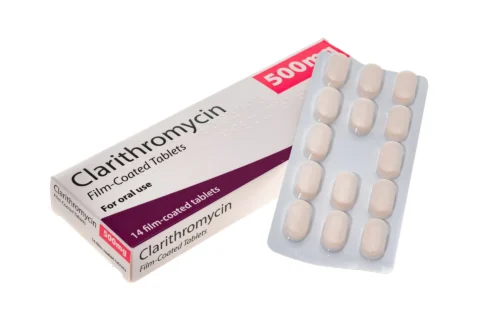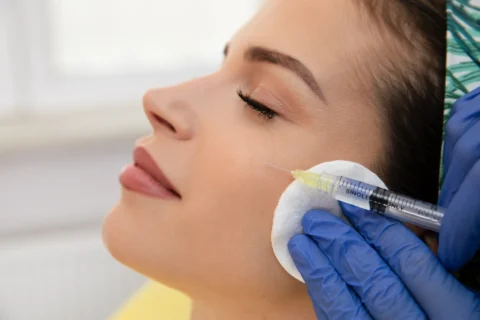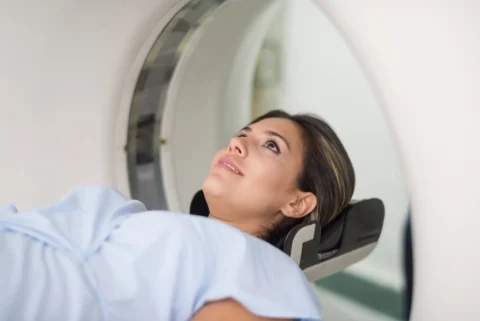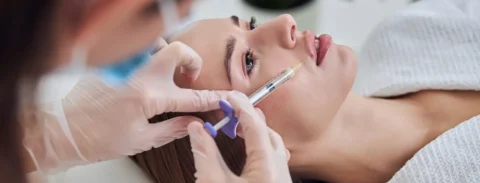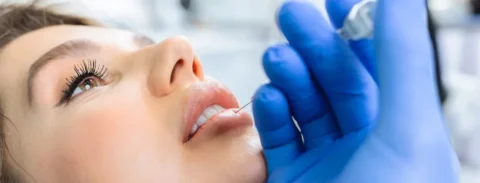Over the years, dermal filler injections have provided numerous patients with significant advantages, improving their quality of life. Patients have had injections for facial rejuvenation, reduction of wrinkles and fine lines, as well as for lip augmentation, whether for cosmetic, reconstructive, or aging considerations. However, there is a small percentage of cases where injectable facial fillers have resulted in complications by causing foreign body granuloma.
So is granuloma nodule formation normal after getting lip fillers? The body naturally tries to get rid of the foreign substance, which is what occurs during granuloma formation: the body tries to fight off the injected product in response. Any dermal filler can be administered with the risk of foreign body granulomas developing. Foreign body granuloma formation is influenced by different factors such as injection volume, filler contaminants, and filler physical characteristics.
Are Granuloma Lip Filler Nodules Normal?
Numerous facial soft tissue fillers have the well-known side effect of causing lump formation called facial granulomas. Silicone, calcium hydroxyapatite, PMMA, and hydrogel are a few of these fillers. The desired soft tissue effect is achieved by the foreign body reaction for most of these substances.
To put it another way, when the body encounters a foreign substance, inflammatory cells are deposited and they secrete collagen, which sticks around and fills in the space that was previously hollow. The underlying skin is filled in by the collagen reaction to correct the irregularity that led to the necessity for the injectable dermal fillers procedure.
Factors That Affect Granuloma Formation
As far as size is concerned, facial granulomas from dermal fillers are self-limited. These lumps don’t move around. The patient’s overall medical health is unaffected by the granuloma formation. These superficial lesions on the face only need to be treated for aesthetic reasons. Foreign body granuloma, regardless of where it exists, is the result of a product being administered to the skin in the inappropriate position, most frequently too superficially.
These dermal filler complications seldom induce systemic illness due to their superficial placement. Physician error would be more likely to cause serious issues than the product itself. The range of these lesions is constrained, and they have no effects outside their immediate area. As a result, a granuloma on the face has no impact on the patient’s nervous system.
If the filler is injected too deeply into the facial muscles to fill them, it may form scar tissue or a granulomatous nodule, which may affect how the corresponding muscle functions. Muscle function may be slightly reduced as a result, but it can be corrected by removing the granuloma. Rarely, patients who receive soft tissue injections may develop a systemic disease.
However, the majority of diseases are brought on by the injection of non-sterile substances or by the substance eroding through the skin and causing an infection. That systemic illness is caused by the infection, not the granuloma. Granulomas are typically minor lesions, so having one wouldn’t affect a patient’s ability to go about their everyday life.
Granuloma From Lip Fillers: Diagnosis and Treatment
The granulomas associated with dermal filler injection procedures are a sign of a hypersensitive reaction to the product. In rare circumstances, the patient has never before experienced a hypersensitive reaction. A granuloma develops as an immunological reaction to the offending product at the areas where it was administered, frequently weeks or months after the treatment.
In other circumstances, the patient may have previously experienced influenza before this delayed reaction. To confirm the diagnosis, histological examination of probable granuloma formation is recommended and required. In the event that dermal filler complications are diagnosed as a granulomatous nodule, then a granuloma treatment plan may be conducted.
Diagnosis of Granuloma From Lip Fillers
It can be difficult to diagnose and treat dermal filler granulomas, therefore it’s important to have a thorough medical and cosmetic history of the patient before selecting which treatment will be most beneficial. The doctor should go over the patient’s history of dermal filler injection procedures, any pre-existing skin infections, and the general state of the skin before the granuloma appeared.
The practitioner’s evaluation of the patient is equally crucial since they must determine whether granulomas actually exist because many different issues might mimic them. The most prevalent of which being filler nodules or lumps, delayed filler hypersensitivity, and infections caused by connective tissue reactions. Facial fillers aren’t the only source of nodular lesions; other causes frequently exhibit varying degrees of inflammatory characteristics.
Treating Lip Filler Granulomas
Despite being frequently empiric, the approach to treatment typically follows a step-by-step sequence of procedures targeted at the most plausible underlying factors. Even with a negative culture, the first level of granuloma treatment normally involves treatment with broad-spectrum antibiotics.
The following or complementary procedure necessitates administering intra-lesional hyaluronidase, particularly if hyaluronic acid filler has been injected. If the nodule contains gel, it can frequently be extracted using a 16-gauge needle puncture and negative pressure. To reduce inflammation, some doctors would intralesionally administer a steroid injection.
Surgical excision is an option as a last resort. Granulomas of different sizes and locations require varying degrees of aesthetic plastic surgery intervention. Most of these are tiny lesions that can be removed directly. The granuloma should entirely disappear with medication or surgical intervention, according to the prognosis. If surgery is utilized, a minimal degree of visible residual scarring may be present.
What Other Adverse Effects Might Lip Fillers Cause?

There are potential risks and side effects with dermal filler injection procedures, just like with any other cosmetic treatment, and not everyone will always experience the same thing. The majority of facial fillers adverse effects manifest themselves a few days after the administration procedure. Usually, they’ll disappear after 1 to 2 weeks. But occasionally an adverse reaction might not show up for several months or even years.
Common Side Effects of Lip Filler Procedures
Minimal inflammation and bruising after lip augmentation procedures are two of the most typical adverse effects. After having a soft tissue augmentation procedure with injectable fillers, such as lip enhancement treatment, you’ll probably experience this for a few days.
Injection sites near and around the mouth or nasolabial fold may also show redness after your doctor administers the dermal filler. Within a few days, the redness from the lip injection procedure should subside. Contact your dermal filler provider immediately if you notice persistent redness, swelling, or severe bruising.
Serious Adverse Events of Lip Filler Procedures
If you’re considering lip fillers, you should be aware of some serious adverse effects. The purpose of understanding the potential adverse effects of injectable dermal fillers is to educate you rather than to alarm you. After undergoing lip enhancement treatment, a skin lump or breakout may develop.
A patient should be aware that all lip augmentation procedures, whether aesthetic plastic surgery or injectables, have the potential to cause adverse reactions. The following are also some of the serious side effects to keep an eye out for with lip fillers, including:
- Skin infections
- Reemergence of cold sores
- Asymmetry and substandard aesthetic results
- Inflammatory reactions
- Tissue damage that results in scarring, necrosis, or ulceration
Itching is a significant adverse reaction of lip fillers that may indicate an allergic reaction. Injectable dermal fillers can potentially cause significant adverse effects like skin damage and scarring near to the injection site. Additionally, vascular occlusion, which occurs when blood vessels are blocked, is one of the potentially fatal adverse effects. Vascular occlusion can result in blood clots and dead tissue, making this extremely risky.
Are Lip Fillers Reversible?
Lip fillers are commonly removed due to buyer’s remorse, which is a very common reason for women to want the treatment reversed. They most likely visited a cosmetic clinic where the soft tissue augmentation procedure with injectable fillers was done at a heavily discounted price. The ultimate result is typically an unnatural inflation of the lips that slightly resembles those of a cartoon character.
Regardless of the reasons, there are a few approaches to getting lip fillers removed:
- Stop receiving maintenance: Skipping maintenance injections when they are required is one of the simplest methods to maintain the full lip look. The volume of the lips will partially decrease as a result of this, but not entirely. Most of the time, just 85% of the volume will dissolve.
- Receive a treatment of hyaluronidase injections: Administering hyaluronidase into the lips will eventually cause the hyaluronic acid to break down. Take note that various brand names of fillers, such as Bellafill, Radiesse, and Sculptra, are permanent filler lines and can’t be reversed by Hyaluronidase. In cases like this, the patient will either need to wait for their body to metabolize the fillers or receive a steroid injection. The best outcomes come from seeing a plastic surgeon before making a decision.
Potential Adverse Effects of Lip Filler Removal
You might be surprised to learn that getting rid of lip fillers is a little more complicated than it seems. The majority of people don’t consider the following warnings when they initially decide to get lip injections:
- Not all dermal filler injection procedures are reversible: There are some lip fillers that are not entirely reversible; this depends on the specific filler that was used. If your doctor didn’t administer Teosyal, Juvéderm, or Restylane, there’s a good chance that the procedure can’t be reversed or will require more time to dissolve. A hyaluronidase injection can be used to reverse the three injectable facial fillers indicated above; it starts working almost immediately and takes a few hours to complete.
There can be long-lasting changes: The majority of people only notice an 80% to 85% drop in lip volume even after the hyaluronidase injection is administered and the volume of the lips begins to decrease. If a person has had multiple filler injections over time or utilized permanent filler, there is a possibility that even after the filler has completely dissolved, the lips may still have some fullness that may never go away naturally.
Lip Filler Aftercare to Avoid Granuloma Nodule Formation
No clinical downtime is required following your lip filler procedure. You can resume your everyday activities while following the aftercare instructions because you’re neither bedridden or in need of rest. But there may be downtime needed for your appearance, which suggests that you might feel discomfort for a few days following your procedure and have some swelling, mild bruising, and discomfort.
Reduce bruising, swelling, and soreness for at least 24 hours following the cosmetic filler treatment by applying ice, taking arnica tablets, avoiding hot baths, saunas, and steam rooms, as well as engaging in strenuous exercise. The product injected won’t be shifted into undesirable places, such as the area around the lips or nasolabial fold, if you avoid rubbing or massaging the area and sleep on your back.
Taking good care of yourself and being sensible will help your lips heal and your injection points settle. After your treatment, it’s also important to refrain from drinking too much alcohol and hot beverages. Your lips might still be slightly numb after the procedure since dermal fillers contain an anesthetic, and consuming anything too hot could burn your lips without your knowledge.
Alcohol masks sensations while also increasing vascular activity, so while a glass of wine won’t hurt, drinking excessively after your treatment runs the danger of increasing bruising and making you forget the aftercare instructions, which could result in you accidentally touching or irritating your lips.
Get Affordable Medical Tools and Devices From FACE Med Store
There’s a possibility that granulomas may result from injections of cosmetic filler, sometimes resulting in tissue damage and almost always triggering anxiety in patients. In order to avoid a botched lip injection, only have your procedure done by a board-certified plastic surgeon or dermatologist who has extensive experience with this facial rejuvenation procedure.
As a leading medical device and tool provider in New York, FACE Med Store has years of experience providing high-quality and affordable devices and tools to cosmetic practices. We help provide our clients with access to ground-breaking goods, owing to our in-depth understanding of the most recent advancements in the cosmetic industry. Contact us now for additional details about our services and our current stock list.

